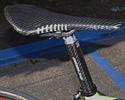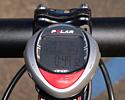
Recently on Cyclingnews.com |
Pro bikes, March 1, 2007
Luca Paolini's Liquigas Cannondale System Six
By James Huang As compared to the rather international nature of most ProTour teams these days, the Liquigas team is somewhat of a standout being decidedly Italy-centric is nearly all respects. The team retains a nearly 100% Italian roster as well as a panoply of like-oriented sponsors, including nearly all of its clothing and equipment, its team cars, and even the pasta and coffee the team eats and drinks. This year, though, Liquigas has traded the trademark celeste green colors of its former Italian bicycle sponsor, Bianchi, for the distinctly red, white, and blue hues of US-based Cannondale. Cannondale has supplied the team with both its carbon fiber and aluminum System Six as well as the full carbon Synapse. Team Liaison Rory Mason stated that most of the team will opt for the somewhat cushier Synapse when it comes time to ride the cobbles in the Spring classics, but the majority of the team usually chooses the edgier System Six otherwise, including one-day specialist Luca Paolini. According to Mason, "The System Six was designed for one purpose, and that's performance. The attributes that we've designed into this frame to achieve that were a high level of frontal stiffness or rigidity, while maintaining very light weight as well." Cannondale utilizes a novel mix of materials for the System Six, which uses carbon fiber for the top, head, and down tubes, in combination with its tried-and-true aluminum for the seat tube and entire rear end. While this goes in contrast with today's norm, Cannondale claims its pared-down seatstays offer up near-carbon fiber levels of rider comfort. Paolini's stock System Six frame is said to be particularly well-suited to his needs as a one-day racer, especially in regards to his finishing sprint. Mason added, "The top tube is ovalized on a horizontal plane so that it's very stiff side-to-side for accelerations, and we have a very large down tube which comes in two different size-specific diameters." Additional rigidity and responsiveness are gained through the System Six's massive front end, which includes a dramatically tapered steerer tube on the System Six Carbon fork (measuring a standard 1 1/8" diameter up top for ease of stem compatibility to an enormous 1 ½" down at the fork crown) along with the similarly sized head tube. Cannondale also continues its long-standing tendencies towards System Integration with its newest Hollowgram Si crankset that is claimed to be both lighter and more rigid than Shimano's Dura-Ace. Other than the crankset, the rest of Paolini's bike is an almost 100% Italian affair, including Campagnolo Record derailleurs, brakes, carbon seatpost, and Ergopower levers, carbon fiber RacingSpeed wheels from Fulcrum, and fi'zi:k's newest Arione k:1 saddle. Depending on how you look at it, even Paolini's FSA handlebar and stem are Italian as well (FSA operates an office and major facility in Milan). Paolini hopes to continue some of his successes of last year, which saw him claim a victory in Stage 12 of the Vuelta a España and a coveted third place in Milan-San Remo which, coincidentally, began in his hometown. Although early in the season, Paolini is clearly wasting little time in making good on his goals as he debuted his new System Six to a second place podium finish at Stage 2 of this year's Tour of California, and he will continue to aim high for the rest of the season. Paolini's primary goals include the Ronde Van Vlaanderen, the Vattenfall Cyclassics in Hamburg, as well as stage wins in the Tour de France, and ultimately, he hopes to arrive at the World Championships in good form. PhotosFor a thumbnail gallery of these images, click here Images by James Huang/Cyclingnews.com
| |||||
Full specificationFrame: Cannondale System Six, 50cm Critical measurements Bottom bracket: Cannondale Hollowgram Si |
Wheelset: Fulcrum RacingSpeed tubular Bars: FSA Energy T Pedals: Look Keo Carbon Liquigas Team Edition Total bike weight: 7.04kg (15.5lb) | ||||






